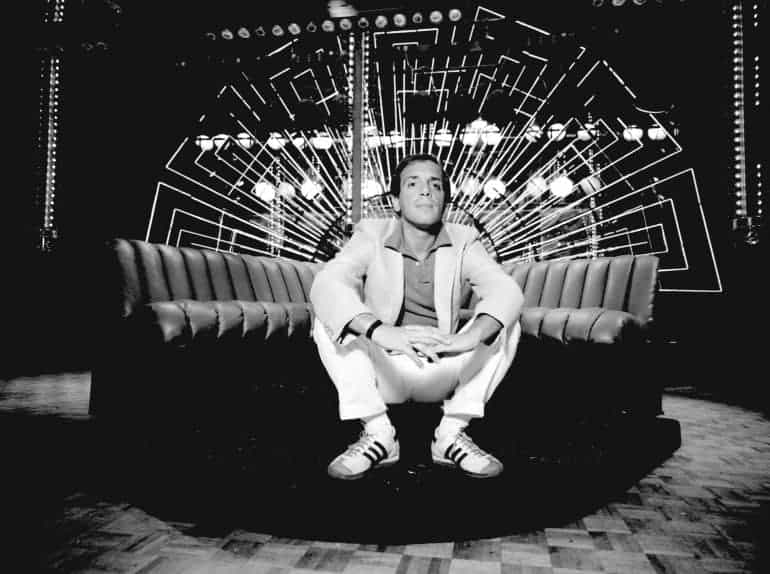By the early 1970s, Steve Rubell was in his thirties and already an established businessman. He and his friend Ian Schrager were New Yorkers born and bred, and following a stint in the National Guard, Steve worked in a brokerage firm for a while. After all, he did possess a Master’s Degree in Finance.
But soon the desire to run his own business proved too strong. He bought two steak restaurants, one in Queens, New York and one in Mystic, Connecticut. This was the humble beginning of what was to become an empire.
Embed from Getty ImagesFor an entrepreneur as ambitious as Steve, the disco boom of the 1970s presented a wealth of new money-making opportunities. Though it was a world in which he himself was a novice, he quickly realized the potential. He and Ian went into business together on a pair of clubs, one out in Boston and one in Queens. Cutting his teeth, so to speak, in the world of disco.
Studio 54
But Steve’s career didn’t really take off until 1977. The CBS network’s famed Studio 52, which had been the location for live recordings of such shows as What’s My Line?, The $64,000 Question, The Jack Benny Show and Beat the Clock, was put up for sale by the network in 1976.
They were moving the bulk of their production to the Ed Sullivan Theater and the CBS Broadcast Center, leaving the famous old venue sadly obsolete. Various parties took an interest in the property, but in the end, it was Steve Rubell and his buddy Ian Schrager who managed to procure a financial backer to turn it into a nightclub, rechristened Studio 54. They spent $400,000 revamping the place and it opened in 1977.
Embed from Getty ImagesStudio 54 was an instant hit. It proved to be a cultural hub and Steve himself was the trendsetter and the tastemaker. He was the one with absolute power over the plucky hopefuls trying to enter this most exclusive of clubs. If he did not like your looks, or your fashion did not meet his very particular standards, then you were denied entry.
The band Chic wrote a song about this experience called “Le Freak.” It was a smash hit single and stands as a perfect emblem of the disco era, but it is also haunted by the all-powerful figure of Steve Rubell. This totalitarian approach to club management had its dark side too. There are plenty of tales of the ambitious attempts made by would-be guests to gain entry to the club, scaling the walls and adopting disguises.
But one particularly grim incident resulted in one gate crasher becoming trapped in the club’s ventilation system and suffocating to death. In many ways that encapsulated the nature of Studio 45. The outrageous debauchery and dissipation, tinged with corruption and sleaze.
Embed from Getty ImagesBut even that could not stop the club’s relentless rise to prominence. Indeed, during the thirty-three months of Steve’s tenure as manager, Studio 54 was a cultural juggernaut. The once decrepit old soundstage was now abuzz with celebrity gossip and scandal.
Steve’s showmanship was unparalleled, and he attracted a whole host of stars to the club. Studio 54 hosted Andy Warhol’s 50th birthday party. In a symbolic gesture of hedonism and decadence, Steve gifted the famed pop artist a trash can filled to the brim with dollar bills.
Stories are still told today of the mad Quaalude-fuelled orgies spilling out into the street, of Bianca Jagger taking to the dance floor on a white steed, of the club bafflingly flooded with livestock in honor of Dolly Parton, of Karl Lagerfeld’s 18th-Century soiree, of drugs, sex, and never-ending parties. Studio 54 was gleefully billed as a “Modern Gomorrah.”
Embed from Getty ImagesBut from the very beginning, Steve Rubell found himself at odds with the law. When Studio 54 had only been open for a month, it was raided by police and shut down for selling liquor without a license. This, Rubell was quick to assure press and patrons, was all the result of a misunderstanding.
The place was a goldmine. And when, in 1978, Steve made the bold claim that its money-making capabilities were second only to the Mafia, it was perhaps only natural that the IRS should take an interest in him.
Studio 54 had raked in seven million dollars in its first year of operation; a startling amount even by today’s standards. Irregularities in their accounts led to yet another raid, this time resulting in the arrest of Steve and Ian.
They hired controversial celebrity lawyer Roy Cohn (who had made a name for himself as chief counsel to Senator Joseph McCarthy, the orchestrator of the communist witch hunts of the 1950s) to defend them, but even that could not save them from disgrace.
Embed from Getty ImagesIt transpired that they had in fact skimmed a total of $2.5 million from the profits. And so, less than three years after its reopening, the writing was on the wall for Studio 54. But Steve wasn’t going to let the occasion pass without one last big blow-out.
A party was held at the club on the night of February 2nd, 1980 which boasted one of the most illustrious guest lists the place had ever seen. Jack Nicholson, Sylvester Stallone, Richard Gere, Margaux Hemingway, Farrah Fawcett, all these were in attendance.
And the performers included Diana Ross and Liza Minnelli. But the event was a poignant one for Steve and Ian. They had pleaded guilty to income tax evasion and received a sentence of three and a half years in jail. They began their sentence on February 4th.
In the event, Steve Rubell and Ian Schrager only served thirteen months of their sentence, but the New York they returned to was not the one they had left. The AIDs crisis was rearing its ugly head, and the club scene was not so dominant as it had been in the ’70s. The hard-partying days were over.
Steve worked hard to re-establish himself, and he did indeed manage to regain some of his former glory, if only by virtue of nostalgia. Studio 54 was never the same again, though it did live on in an adulterated, bastardized form. Steve and Ian Schrager remained firm friends and opened a hotel together on Madison Avenue called Morgans.
Steve also had a role in the establishment of the famed Palladium club. The Palladium had previously been an iconic music venue with a particular association with the genre of heavy metal. Bands like Judas Priest, Iron Maiden and Motorhead had made themselves at home there in the past.
But under Steve’s influence, the Palladium took a more new wave direction musically. The Palladium club, like just about every other venue Steve had an interest in, proved to be a big success. It was an iconic building, inseparably bound to New York’s ’80s club scene just as Studio 54 had been in the ’70s.
But what the Palladium lacked was mythology. While he still knew how to attract make money and schmooze celebrities, Steve seemed to have lost the knack for generating good copy. More and more, he was living on the glories of the past. And he was soon in for a grim wake-up call.
Embed from Getty ImagesSteve Rubell was gay but remained in the closet for much of his life. As such, when he contracted HIV in 1985, he opted to keep it quiet. This, however, progressed to full-blown AIDs at the height of the crisis that was sweeping the world throughout the ’80s.
He found it hard to leave behind his hard-partying lifestyle, and continued to drink and engage in recreational drug use on top of the AZT treatment he was undergoing. This left his health in a very precarious state and he suffered a whole host of infections and complications.
His rapid decline was no doubt hastened by his refusal to compromise the wild hedonism to which he had become accustomed, not to mention his obsessive desire for secrecy surrounding his illness. This was not uncommon in public figures who contracted the disease, and it perhaps explains why he came to check into New York City’s Beth Israel Medical Center under a false name in the summer of 1989.
Apparently, this was for the treatment of hepatitis and peptic ulcers. Steve Rubell died there on July 25th.
Embed from Getty ImagesSteve Rubell – Legacy
His legacy, and the mark he made on the cultural sphere within New York, is indicated by the circumstances of his funeral. It was a comparatively small affair, with only around seventy-five mourners for so prominent a public figure.
But among their numbers were the great and the good, some of the most iconic figures of the last few decades. People like Calvin Klein, Bianca Jagger and even Donald Trump, who made a speech praising Steve’s “loyalty” and bemoaning those who had abandoned him on his release from jail.
Trump credited Steve with transforming New York. Which, in many ways, he did. For better or worse, and in the face of notable controversy, Steve Rubell was a man who left his mark.
Similar Stories…
- Margaux Hemingway – 14 Interesting Facts You Probably Didn’t Know
- Candy Darling – Life, Stardom, and the Andy Warhol Years
- Bianca Jagger – The Life & Times of Style Icon & Activist
- The Alice Cooper Fact Sheet – 5 Things You Need To Know - January 12, 2023
- Everybody Knows The Words, But What Is Hotel California About? - April 29, 2022
- What Is The Meaning Of Stairway To Heaven: Led Zeppelin’s Amazing 1971 Musical Epic? - April 24, 2022


